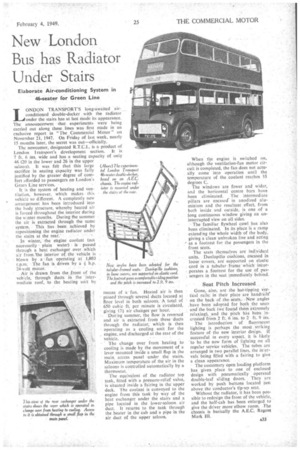New London
Page 25

If you've noticed an error in this article please click here to report it so we can fix it.
Bus has Radiator Under Stairs
Elaborate Air-conditioning System in 46-seater for Green Line
ONDON TRANSPORT'S long-awaited air conditioned conditioned -double-decker with the radiator . . .
Afunder the stairs has at last made its appearance. The announcement that experiments were being carried out along these lines was first made in an exclusive report in "The .Commercial Motor" on November 21, 1947, On Friday of last week, nearly 15 months later, the secret was out—officially.
The newcomer, designated R.T.C.I., is a product of London 1 ransport's development section. It is 7 ft. 6 ins, wide and has a seating capacity of only 46 (20 in the lower and 26 in the upper saloon). It was felt that this large sacrifice in seating capacity was fully justified by the greater degree Of comfort afforded to passengers on London's Green Line services.
It is the system of heating and ventilation, however, which makesthis vehicle so different. A completely new arrangement has been introduced into the body structure, whereby heated air is forced throughout the interior during the winter months. During' the summer the air is extracted through the -same ' system. This has been achieved by repositioning the engine radiator under the stairs at the rear': . In winter,-the engine coolant (not necessarily plain ' water) : is . passed through a heat exchanger over _Which air from_ithe interior of. the vehicle Is blown by 'a Ian operatipg at ipo r.p.m. The fan is driven by a' 4hp.
24-volt mown'. -• .Air is drawn from the front of the vehicle, through ducts in the intermediate roof, to the heatin-g unit by
means of a fan. • Heated air . is then passed through severalduets located at floor level in both saloon's. "A -total Of 650 cubic ft: per minute is circulated, giving -174 air changes-per-hour. • During summer, the flow is reversed and air is extracted from these -duets through the radiator, which is then operating as a cooling unit for the engine, and discharged at the rear of the
vehicle. , The change over from heating to cooling is made by the movement of a lever mounted inside a small flap in the main_ access panel under the stairs. Maximum temperature of the air in the saloons is controlled automatically by a thermostat.
The equivalent of .the radiator top tank, fitted with a Pressure-relief valve, is situated inside a fairing in the upper deck. The coolant is conveyed to the engine from this tank by way of the heat exchanger under the stairs and a pipe located in the lower-saloon, air duct.. It returns to the-lank through the heater in the "cab and a pipe in the
air duct of the upper saloon. " When the engine is switched on, although the ventilation-fan motor circuit is completed, the fan does not actually come into operation until the temperature of the coolant reaches 55 degrees C.
The windows are fewer and wider, and the horizontal centre bars have been eliminated. -The intermediate pillars are encased" in anodized aluminium and the resultant effect, from both inside and outside, is one of a long continuous window giving an uninterrupted view on all sides.
The familiar flywheel cowl has also been eliminated. In its place is a ramp extending the whole Width. of the body, giving a clean unbroken line and acting as a footrest for -the passengers in the front seats. . • .
The seats themselves are individual units. Dunlopillo cushions, encased in loose covers, are supported on elastic cord in a: tubular frame.which•-intorporetes a .footrest for the use of passengers in the seat immediately behind.
• Seat Pitch iacreaoed.
• Gone,also, are the hat-tipping iertical rails: in their place are handrails° "on the back of .the-seats.. New angles .have been adopted for both the seats ,
and the back (we' found them. extremely relaxing), and the pitch has been increasedliom 2 ft. 6 ins. to 2 ft: 9 ins. The introduction of fluorescent lighting is perhaps the most striking feature of the new interior design. If successful in every aspect, it is likely 'to be the new form of lighting on all regular service vehicles. The tubes are arranged in two parallel lines, the intervals-being filled with a fairing to give
a clean appearance.
• The customary open loading platform has. given place to one of enclosed design with pneumatically Operated double-leaf sliding doors. . They are worked by push buttons located just above the conductor's tip-up seat.
. Without the radiator, it has been possible to redesign the front of the vehicle, and the half-cab has been enlarged to give the driver more elbow room. The chassis is basically the A.E.C. Regent Mark


























